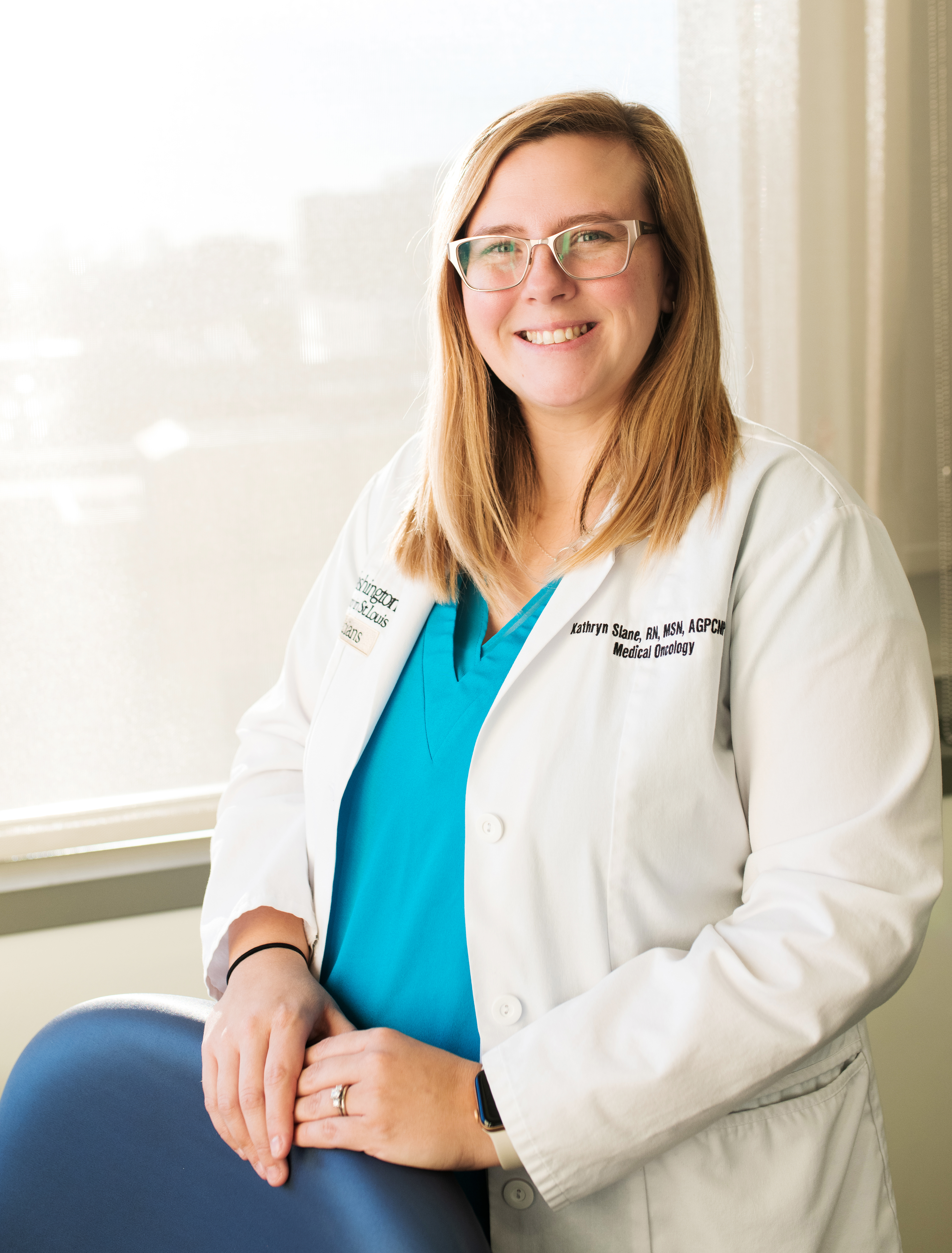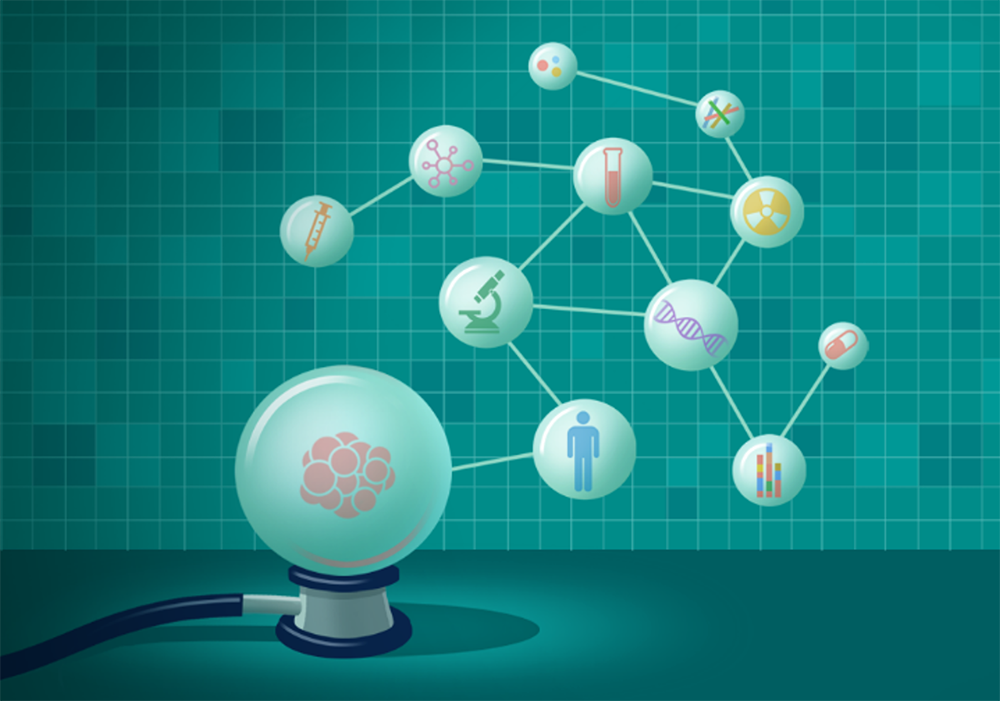Biomarkers, also called molecular markers or signature molecules, can help clinicians characterize alterations in tumors through the detection of specific DNA, RNA, protein, or metabolomic profiles. These pieces of the cancer puzzle are part of precision oncology that the cancer care team can use to assess patients’ cancer risk and prognosis or monitor disease progression. Biomarkers are also a key factor in determining and tailoring treatment methods and their likelihood of success.
“Biomarkers can help clinicians to narrow down a primary site of disease, identify targeted therapies or clinical trials as lines of treatments for patients, and assess disease response and progression,” ONS member Kathryn Slane, MSN, AGPCNP-BC, AOCNP®, advanced oncology certified nurse practitioner at the Siteman Cancer Center and Washington University School of Medicine in St. Louis, MO, and member of the St. Louis ONS Chapter, said. Slane was involved in ONS’s Genomics Advisory Board and the ONS Biomarker Database, a tool that brings precision oncology and the most recent biomarker advancements to the point of care. “Biomarkers and precision oncology are a prime area of focus, and our understanding is frequently changing and expanding.”

“Some biomarkers occur in healthy human cells and can be altered or overexpressed. And in some cases, they have to be present for a therapeutic agent to work,” ONS member Lynne Brophy, MSN, PMGT-BC, APRN-CNS, AOCN®, oncology clinical nurse specialist at the Stefanie Spielman Comprehensive Breast Center, which is a part of the Ohio State University Comprehensive Cancer Center in Columbus, OH, said. Brophy was also part of the team that created the ONS Biomarker Database.
Biomarker Testing and Its Role in Screening and Treatment
According to the National Cancer Institute, each person’s cancer has a unique pattern of biomarkers. Testing a person’s biomarkers provides information on the genetic makeup of their cancer cells and the effectiveness of certain treatments, and it helps providers monitor cancer during and after treatment.
Biomarkers can be classified as predictive, diagnostic, and prognostic, among others. The ONS Genomics Taxonomy is a comprehensive reference list of those and other genomics terms.
- Predictive: Biomarkers that indicate increased risk of developing cancer (e.g., A finding of BRCA1 indicates the need to offer the patient earlier breast cancer screening, prophylactic therapies or surgeries.)
- Diagnostic: Biomarkers that indicate the presence and type of cancer (e.g., classifying a breast cancer as HER2+)
- Prognostic: Biomarkers that measure risk of cancer progression or other clinical events (e.g., A finding of BRAF is a positive predictor for BRAF inhibitor therapy and a negative predictor for anti-EGFR therapy.)

“Biomarker testing can be performed in many ways: through next-generation sequencing and looking at the genome of the cancer cell (e.g., tissue or liquid biopsy) or through immunohistochemistry (IHC) or fluorescence in situ hybridization (FISH),” Slane said. “How we interpret the results varies from biomarker to biomarker and by disease type. For example, HER2 can be assessed by IHC, FISH, or next-generation sequencing. But for some cancers, such as salivary duct carcinoma or gastric cancer, the biomarker must be overexpressed on the cell surface to be a significant finding and IHC is the preferred method of testing.”
Different types of biomarker testing technologies look for different types of biomarkers that can indicate different findings, but all somatic biomarker testing uses tissue or blood samples. Once testing identifies a patient’s biomarkers, the cancer care team determines whether any of the alterations are actionable, meaning that a genetic change driving tumor growth can be targeted with an available drug or treatment modality. The team then reviews the findings and treatment recommendations with the patient.
Patient Education for Biomarkers and Treatment Approaches
“One way I explain it to patients is: In your house, you have a door with a lock, and you’ve got a key that you have to put in that lock to open that door,” Brophy explained. “Normal, healthy breast tissue can have locks on the outside of the cell, and the key to those locks can be hormones—estrogen and progesterone—that work on normal, healthy breast cells. Sometimes, you have a gene, or other changes in your cells happen, and the breast cancer cell makes more of these locks and requires hormones to fit into those locks to help grow. So, when we give hormone-blocking therapy for breast cancer, it’s almost like we’re putting gum into that lock so that the key can’t fit in the lock and help the cancer cell grow.”
In other instances, the goal is to find the right key to unlock certain locks. Brophy used HER2 as an example, a biomarker that can be associated with breast cancer. When cells overexpress HER2, trastuzumab unlocks the doors on the cell’s surface. “If you give somebody trastuzumab, or a key that fits only a certain lock, and the patient doesn’t have the HER2/neu biomarker, there is no place for the trastuzumab to attach. Patients need to be told, ‘You will meet people who are getting different treatments than you are, and that is sometimes because of the biomarkers that they have. If you don’t have the lock, it’s not worth getting the treatment that is a key for only that lock.’”
Biomarkers can also indicate a need for increased surveillance and cancer screening in a person who has not been diagnosed with cancer. Brophy provided another example: A patient learns that they carry the BRCA1 pathogenic, or harmful, variant, which was found via a germline biomarker test. The BRCA1 pathogenic variant is a susceptibility marker associated with a higher risk of breast and other types of cancer, and the oncology nurse and interprofessional team should refer the patient to a genetics healthcare professional and more frequent screening. Brophy added that the patient may have surgical and medication-based options to further lower their risk.
The cancer care team—including a genetics professional—tailors which biomarkers are tested based on a patient’s family history and cancer type, so oncology nurses should keep in mind the key biomarkers in their patient population. For lung cancer, it’s EGFR, ALK, ROS1, BRAF, MET exon 14 skipping, RET, KRAS, NTRK, and PD-L1, whereas in breast cancer, common ones are estrogen and progesterone receptors, BRAC1, BRAC2, and HER2. The ONS Biomarker Database contains an even more comprehensive list.
“It’s a good idea to look at the National Comprehensive Cancer Network (NCCN) guidelines and talk to your treatment team to find out what the key biomarkers are that everybody is tested for,” Brophy said.
An Interprofessional Team Collaborates to Conduct Biomarker Testing and Interpret Results
All oncology nurses have an essential role in biomarker testing and understanding the results. Depending on the clinical environment and level of practice, nurses may conduct preauthorization, reinforce a provider’s patient education about results or treatment options, and more, particularly those working in smaller settings.
“Most oncology care is given in physician’s officers and small clinics throughout the nation,” Brophy said. “Those nurses have to be a jack-of-all-trades when it comes to biomarkers.”
In her practice, Brophy said that an interprofessional team of medical oncologists, physician assistants, and nurse practitioners; study coordinators or research associates if a clinical trial is involved; genetics healthcare professionals; staff nurses; pharmacists; and pathologists works together to care for patients who are undergoing biomarker testing. She added that in most cases, the physician will order somatic biomarker testing, but oncology nurses should advocate for their patients if they feel additional testing should be completed. Usually, rare tumors undergo biomarker testing panels per NCCN guidelines.
“Oncology nurses are the ones who communicate the most with the patients and educate the patient the most out of any member of the care team, in my experience,” Slane added. “Whether they are nurse coordinators or treatment room nurses or on the inpatient side, the nurses are the ones that the patients feel like they can talk to the most and ask questions to.”
Closing Oncology Nursing’s Educational Gaps
Researchers have identified knowledge and practice gaps in precision oncology among the nursing population, such as a lack of exposure to and understanding of molecular-level research and technology and how analysis can facilitate personalized treatments for patients with cancer.
In Slane’s practice, patients frequently ask about biomarkers, testing, and surveillance in patient care. Slane said that those questions typically get forwarded to advanced practice providers or physicians, not because nurses don’t want to educate their patients on the topic, but rather they don’t feel confident with the information.
“We are working diligently to close the educational gaps. By improving the knowledge and confidence in biomarkers for our nurses and all members of the care team, we can help patients feel more involved in their care and more optimistic on their treatment strategies when they understand precision medicine,” Slane said.
Patient Education for Biomarker Testing and Results
Brophy and Slane agreed that self-education enables oncology nurses to create best practices in biomarker patient education. They suggested that nurses and healthcare professionals stay up to date on NCCN guidelines for biomarker testing to fully understand the results’ therapeutic implications.
“Nurses in particular should know about NCCN’s patient education materials and talk to patients about biomarkers and other facets of treatment,” Brophy said. She also referred nurses to professional resources, such as those from the Society for Immunotherapy of Cancer and the ONS Biomarker Database and Genomics and Precision Oncology Learning Library.
“Biomarkers and biomarker testing is a vast field that can be overwhelming and difficult to understand, let alone explain. But biomarkers are not going away, and they are only going to grow in their importance for our patients with cancer,” Slane said. “ONS and other organizations such as NCCN are working to provide up-to-date, easy-to-navigate staff and patient education materials. Use these resources.”






